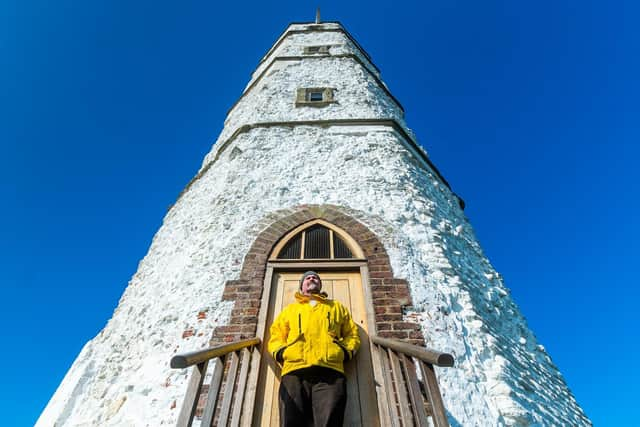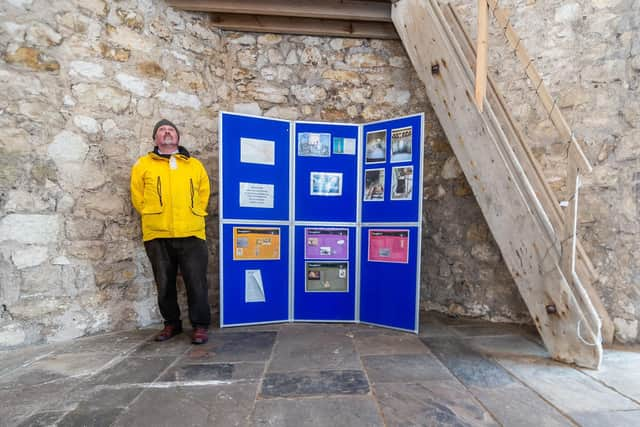Meet the volunteers who want to turn Flamborough's unique Chalk Tower from an 'empty shell' into an exhibition and event space
Believed to be one of the tallest chalk buildings in the world, it was an early form of maritime communication that pre-dated lighthouses.
Two enterprising businessmen planned a chain of similar towers along the North Sea coast, but Flamborough was one of the few ever completed in 1673. In the immediate aftermath of the Civil War, sea trade was picking up again and John Clayton and George Blake’s idea - which they proposed to King Charles II - was for their network of flag signal stations to relay messages from ports to inland settlements regarding the arrivals of ships and valuable cargo. They envisioned that their service would be funded by ship owners - but in reality it was not well-supported and eventually bankrupted them, leaving the Chalk Tower to find a new role.
Advertisement
Hide AdAdvertisement
Hide AdIt became a useful navigational asset, however, even before the building of the Flamborough lighthouse by Trinity House in 1806. The Royal Navy used it for signalling and once the telegraph was invented in the 19th century, it was converted for use as a wire station.


Its looming presence helped to prevent smuggling and to monitor disputes between local fishermen as a result of a cut-throat rivalry between the boats of Flamborough and Bridlington, whose war and sabotage attempts in the 1860s forced the Navy to send an officer to patrol the headland and keep the peace.
Unlike many navigational buildings, it was never actually owned by Trinity House; in 1938 it was acquired by Bridlington’s borough councillors, who bought it as a sort of buffer against holiday accommodation development on the Head.
War broke out soon after, and the Royal Observer Corps occupied the building to keep an eye on enemy shipping - graffiti left by the servicemen can still be seen today. It was also an early radar research station before the function moved to Bempton.


Advertisement
Hide AdAdvertisement
Hide AdIts ownership passed to East Riding Council, who leased the land next to it to a golf club and created a nature reserve, but the tower itself fell into dereliction and was rarely accessible. It wasn’t until the 1990s when a local councillor, Norman Hall, succeeded in persuading the council to fund repairs, and he would occasionally host tours of the building himself.
Now elderly, his baton has passed to the Friends of the Chalk Tower, who formed in 2012 and want to develop his legacy by opening it more regularly, holding events in the space and allowing visitors into all four original rooms.
Retired University of York archaeologist Andrew Jones, who owns a holiday home on the Outer Head, is one of those leading the project and is enthusiastic about the part the Chalk Tower has played in the area’s history.
“We really want to open it up more for visitors, and we’ve had to be very persistent with the council. We want to hold exhibitions and events there rather than it just be an empty shell.”


Advertisement
Hide AdAdvertisement
Hide AdCurrently, volunteers man the tower on Sunday afternoons and for events such as the National Festival of Archaeology and Heritage Open Days. Private tours can also be arranged on request.
“We’ve only got a licence to show people around the ground floor, as the Victorian staircase was built for young naval officers and it’s steep and narrow, so not safe for everyone. There is a hatch onto the roof and our next job is to get that working too. We’d also love to reinstate the original flagpole.
“My dream is to excavate beneath the chalk and build walkways going out to sea!
“You can still see the trapdoor openings in each room which were used to push the flags up to the roof."
Advertisement
Hide AdAdvertisement
Hide AdTheir first exhibition will be a series of photographs taken by Kilburn-based Tessa Bunney depicting lighthouses across the UK - and one of her original subjects, a lighthouse keeper who featured in an image taken in Cornwall, will be a guest at the launch event, as he is now living in a Trinity House retirement flat at the Flamborough site.
“We want art, yoga - there are all sorts of uses now for the benefit of the community. Our vision is to make the whole building accessible.”
Comment Guidelines
National World encourages reader discussion on our stories. User feedback, insights and back-and-forth exchanges add a rich layer of context to reporting. Please review our Community Guidelines before commenting.
